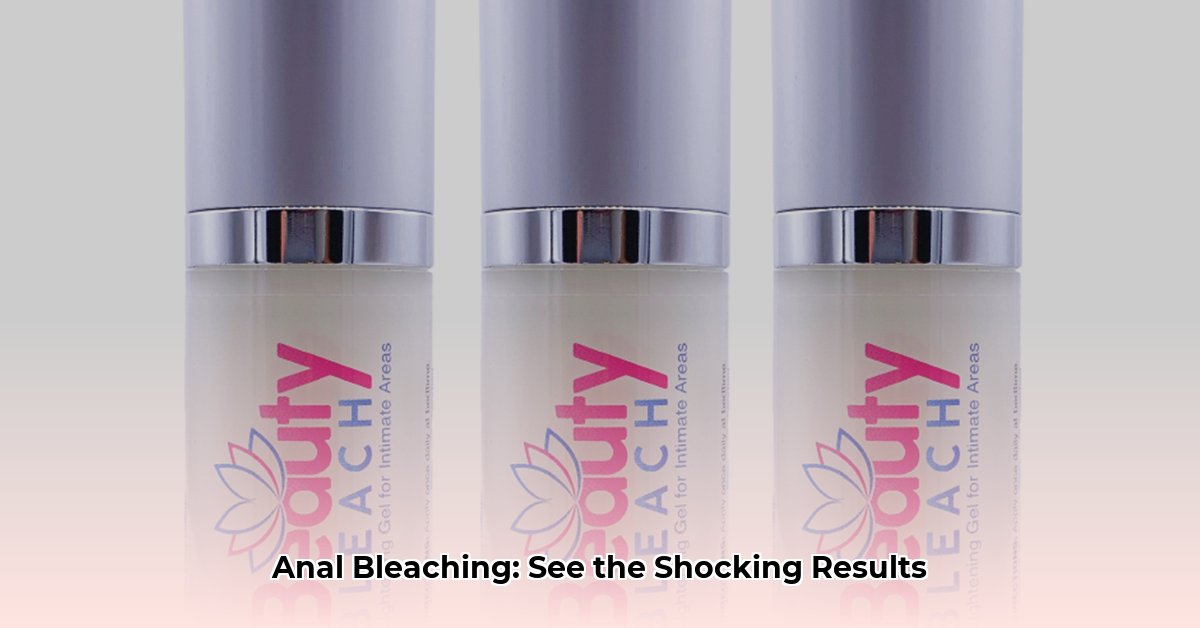Understanding Anal Bleaching: What It Is and Why People Choose It
Anal bleaching, also known as perianal lightening, is a cosmetic procedure that lightens the skin around the anus. While it might seem like a taboo topic, it’s becoming increasingly common. People choose anal bleaching for a variety of reasons, from achieving a desired aesthetic to simply feeling more confident and comfortable in their own skin. This comprehensive guide provides evidence-based information to help you make an informed decision.
How Anal Bleaching Works: A Step-by-Step Guide
Several methods can achieve anal bleaching, each with its own process and expected outcomes. Here’s a breakdown of the most common procedures:
1. Lightening Creams:
- Step 1: A consultation with a qualified dermatologist or aesthetician is crucial to determine if this method is right for you and to discuss potential risks.
- Step 2: The practitioner may recommend a specific over-the-counter or prescription cream containing ingredients like hydroquinone, kojic acid, or azelaic acid.
- Step 3: You’ll typically apply the cream to the affected area twice daily, following the instructions provided.
- Step 4: Results are gradual, usually appearing over several weeks or months. The cream works by reducing melanin production, the pigment responsible for skin color.
2. Chemical Peels:
- Step 1: A consultation ensures the procedure is suitable for your skin type and addresses any concerns.
- Step 2: The practitioner cleanses the area and applies a chemical solution, often containing trichloroacetic acid (TCA) or alpha-hydroxy acids (AHAs).
- Step 3: The solution exfoliates the outer layer of skin, revealing lighter skin underneath.
- Step 4: A neutralizing agent is applied to stop the peeling process.
- Step 5: Multiple sessions may be required to achieve desired results, spaced several weeks apart.
3. Laser Treatments:
- Step 1: Consultation and skin assessment are essential to determine the appropriate laser type and settings.
- Step 2: The practitioner protects the surrounding skin and uses a specialized laser to target melanin in the perianal area.
- Step 3: The laser energy breaks down the melanin, leading to skin lightening.
- Step 4: Multiple sessions might be needed, but results are often quicker and more dramatic than with creams or peels.
Before and After: Visualizing the Results
Visual aids can help you understand the potential outcomes of anal bleaching. While including photos here isn’t possible, searching online for “anal bleaching before and after” will yield numerous examples. Look for images from reputable sources, like medical websites or clinics specializing in dermatological procedures. Remember, results vary, and these photos should not be taken as guarantees.
Risks and Side Effects
Anal bleaching, like any cosmetic procedure, has potential risks and side effects:
- Temporary Irritation: Redness, itching, burning, and swelling are common, usually subsiding within a few days.
- Increased Sensitivity: Sun sensitivity and sensitivity to certain products may occur temporarily.
- Hyperpigmentation or Hypopigmentation (rare): In some cases, the skin may become darker or lighter than intended.
- Infection (rare): Proper aftercare significantly reduces this risk.
- Scarring (rare): More likely with aggressive treatments or improper aftercare.
- Allergic Reactions: Patch testing can minimize this risk.
Cost and Provider Selection
Costs vary depending on the method, location, and provider’s experience:
| Method | Estimated Cost Range |
|---|---|
| Lightening Creams | $20 – $150 |
| Chemical Peels | $100 – $500 |
| Laser Treatments | $300 – $1000+ |
Finding a qualified provider is crucial. Look for:
- Board-certified dermatologist or a licensed aesthetician specializing in intimate area treatments.
- Experience with anal bleaching and positive patient reviews.
- Consultation that thoroughly discusses risks, benefits, and alternatives.
Aftercare Instructions: A Step-by-Step Guide
Proper aftercare is essential:
- Step 1: Gentle Cleansing: Use mild, fragrance-free soap and water. Avoid scrubbing.
- Step 2: Moisturizing: Apply a fragrance-free, hypoallergenic moisturizer as directed.
- Step 3: Avoiding Irritants: Refrain from using scented products, harsh chemicals, or tight-fitting clothing.
- Step 4: Sun Protection: Apply sunscreen with SPF 30 or higher if sun exposure is unavoidable.
- Step 5: Following Provider Instructions: Adhere to any specific instructions given by your practitioner.
Alternatives to Anal Bleaching
If you’re unsure about anal bleaching, consider:
- Addressing underlying hyperpigmentation: Consult a dermatologist about potential causes.
- Acceptance: Remember that all skin tones are beautiful and normal variations exist.
Addressing Psychological Aspects
It’s crucial to consider the emotional and psychological reasons for seeking anal bleaching. Body image concerns and societal pressures may play a role. Talking to a therapist or counselor can be beneficial. Prioritize self-acceptance and make informed decisions aligned with your personal values.
FAQs
Q: How long do results last?
A: Results vary, lasting from months to years, depending on the method and individual factors. Maintenance treatments might be necessary.
Q: Is anal bleaching painful?
A: Most people experience mild discomfort, such as tingling or warmth. Numbing cream can reduce sensation.
Q: Is anal bleaching permanent?
A: No, it’s not permanent. Repeat treatments may be needed to maintain desired results.
Q: Can I perform anal bleaching at home?
A: While at-home kits exist, professional treatment is safer and more effective. Incorrect application can lead to complications.
Conclusion
Anal bleaching is a personal choice. This guide provides information to help you decide if it’s right for you. Consulting with a qualified healthcare professional is essential for personalized advice and to discuss any concerns.
Disclaimer: This information is for educational purposes only and does not constitute medical advice. Consult with a qualified healthcare provider before making any decisions about your health or treatment.
- The Best Bento Box Price For Your Perfect Packed Lunch - December 15, 2025
- Bento Box Shopping Tips for Smart and Stylish Lunch Prep - December 14, 2025
- Bento Box Trays Streamline Restaurant Meal Presentation and Transport - December 13, 2025










